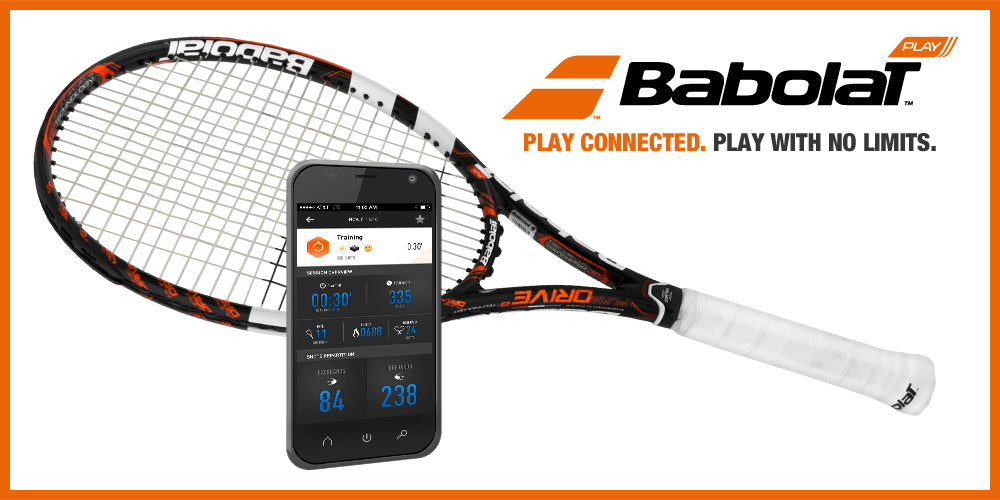Working at Holabird Sports means I always get to see the latest and greatest gadgets, technology, and gear rolling in—especially around the holiday season. As a tennis player, I've always been sort of jealous of the cool heart rate- and GPS-enabled gear that runners can use to analyze and break down every part of their workouts and races. And then, midway through 2012, Babolat announced that they were developing a "Play and Connect" racquet that would allow tennis players to track all sorts of data during their matches and practices.
Fast forward to slightly over a year later, and the ground-breaking Babolat Play Pure Drive and the accompanying app are nearly ready for launch. Ever since I started hearing about the Babolat Play Pure Drive, I've admittedly been cautiously tempering my excitement until I could see for myself whether the Play Pure Drive could deliver the goods as promised. Then, a few weeks ago I got my sample for play-testing, so I cleared my schedule, drafted one of my tennis buddies, and booked some indoor court time.
Before getting any further into this review, I think it's important to note that specification-wise the Play Pure Drive is identical to the regular Babolat Pure Drive GT 2012 and should play the same. With that in mind, I'll focus mainly on the data-tracking capabilities of the racquet, as opposed to the performance of the frame itself.
Before playing with the racquet the first time, you need to set up a profile and pair your racquet with your phone or tablet. The set up process really is easy and only requires a few pretty simple steps. At first I had some minor difficulties, but—admittedly—at least some of that was my own fault for being in a rush. Since I got my sample before the official consumer launch, I've also been running a beta version of the app. Even with some minor issues, the set up still only took me around 10 or 15 minutes, and with the amount of attention and resources that Babolat is devoting to the Play Pure Drive, I'm sure that any and all issues will be ironed before the official launch.
After hitting with the Play Pure Drive and syncing the data with my phone, I've got to say that it's definitely an impressive piece of technology. The racquet tracked my total play time—as well as actual "active time"—along with total shots, shots per minute, and my best rally. The Play Pure Drive is also able to differentiate and track forehands and backhands, as long as you correctly selected your dominant hand during set up and—most impressively—it even tracks approximately where the ball impacts the stringbed.
Once you drill down into the forehand and backhand data, you get a more detailed breakdown of shots that were hit flat or with topspin or slice. The detailed data also assigns an average "power" rating and "spin effect" rating for forehands and backhands. Although I didn't hit any serves during my first session with the Play Pure Drive, the app also displays similar info for first and second serves.
Aside from data-crunching features, the final version of the app will also include some different social features that allow you to compete with friends across the globe, if you choose to do so. The beta version of the app didn't have all of the social features enabled, so I can't really say much more about that now.
Now you may have noticed that I've mentioned forehands and backhands a few times, but I haven't differentiated between groundstrokes and volleys. Unfortunately, the Play Pure Drive does not separately track volleys and groundstrokes. After speaking with a Babolat Play tech rep during a briefing on the racquet, this relatively minor omission actually makes a bit more sense. After doing some testing, the Babolat Play team found that because many players tend to swing at their volleys (a transgression of which I am frequently guilty), the technology actually had a very difficult time differentiating between slices and volleys.
In addition to the lack of separate stats for volleys, there are a few other very minor items I noticed. The Play Pure Drive uses the angle of the racquet face to determine whether the ball was hit flat or with topspin or slice. After syncing my racquet, I noticed that a lot of my forehands and backhands registered as flat, even though I know that I hit nearly every shot with at least some topspin. I also noticed that a rogue overhead slipped into my stats. At first I just dismissed it, thinking I'd forgotten about hitting one, but after talking with our tech rep, it sounds like overheads are detected based on the angle of the racquet fact relative to the handle. If your footwork is a little lazy like mine and you get caught hacking at a few wide forehands, they'll likely get recorded as overheads.
Despite my initial skepticism, I believe the Babolat Play Pure Drive is an amazing tool with a lot of game-changing potential, despite some minor flaws and technical limitations. Even taking the imperfections and the price tag into account, the Play Pure Drive's upside far outweighs any negatives. I think it's a worthy piece of equipment for anyone who's serious about their tennis and really wants some statistical insight into their practice and match-play. The Play Pure Drive is amazing in its own right, but it may have really opened the door for a new generation of innovation as well. I'm very excited to see where this technology leads us a few years down the road.
Order the Babolat Play Pure Drive today!
Babolat Play Racquet & App Review

